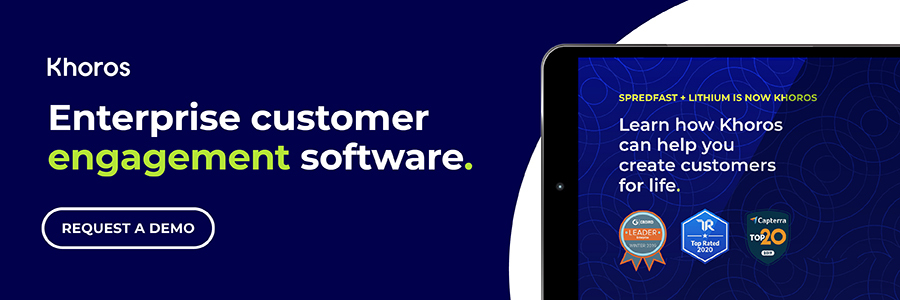 Logo
Logo
EXPERT INSIGHTS
Jul-14-2020
Your community is NOT just another support channel
Michael Puhala, VP Solution Strategy
In this blog series, experts from across Khoros share their valuable knowledge on a topic of their choosing. This month’s author is Michael Puhala, VP Solution Strategy, an expert in Khoros Communities.
Why does a company create a branded community experience for its customers, partners and prospects? Often, it's to either drive down operational support costs or to increase revenue, and usually some combination of both. But building a community is more than the sum of its parts and when done right, it often flourishes well beyond the original vision.

Here at Khoros, we have the distinct advantage of helping 400+ brands build and develop their online community and respective strategy. I’ve been fortunate enough to spend ten years here focused on community building for the enterprise. As someone who gets to witness and learn in a massive watchtower, so to speak, I’ve seen patterns emerge, and one theme has stood out more than any other:
When Community is treated as a strategic asset of the business, it becomes one of the most important conduits an organization has.
Conversely, when Community is treated as any other channel of communication (e.g. call center, email, or social media), it rarely lives up to its potential to make significant business impacts.
A word of advice to any executive that has the responsibility of oversight to the organization’s community efforts: It’s imperative that you don’t treat your community as just another channel. Or put another way: Community is not a commodity.
It has been proven in hundreds of Khoros communities that when Community is given resources, visibility across the organization, and a bi-directional modality of learning, Community becomes a force multiplier beyond an ROI calculation. Let me explain why.
A bit of history
Before the Internet, consumers got help from brands by calling their contact center. Then came email, which often still requires a phone call for final resolution. Call centers and technical support teams grew to meet this demand, but offered little in the way of improving the customer experience.
Then came social media, a new channel for consumers to engage with the brand with the added accountability of a public record. Now brands’ poor customer support was on full display, and this created a demand for higher quality service. Brands scrambled to meet this growing demand by creating elaborate workflows and hiring seas of customer support representatives trained to either close or escalate cases.
Brand communities solve many of the problems associated with these more traditional support methods. And the healthier the community, the better the support.
Community health — and why it matters
I generally classify any given community (whether run on the Khoros platform or not), based on a spectrum of health.

Each axis has a bi-directional outcome. Impact for example, refers specifically to any measurement of improvement for the brand (e.g. CSAT, better product output) and for the customer a better outcome such as faster resolution time or learning a new skill. Value speaks directly to the brand’s return on investment and to the customer’s relationship with the brand and with their peers.
For each client, we invest a great deal of time and effort developing a model to measure how effectively they can use their community to interact with their customer base. The above graphic is a simplified overview of this model — but even this version offers deep insights into the effectiveness of any community. The model measures six different facets of engagement to deliver insights in two general categories: (1) external — how connected a company is to its customers; and (2) internal — how connected is a company to itself in service of its customers.
Community as a customer support channel
Now, let’s focus on the “community as a channel zone” in the graphic above. What does this mean?
There is a significant risk in applying call center oriented workflows, business logic, and agent response to community posts: it’s not only hyper inefficient but also counterproductive to the purpose of community — namely to 1) replace the one-to-one agent interaction with a more scalable peer-to-peer model and 2) pivot support conversations into loyalty opportunities. This is not to say that case escalations derived from community are bad. It can be perfectly appropriate to initiate such a workflow and bring in the right resources to help the customer who is participating in the community. The mistake here, rather, is seeing every customer interaction as a nail and applying a hammer approach. For example, every unanswered community post being escalated to a support ticket. Cases are different, and require different types of attention. That’s what communities are for.
Communities are scalable, peer to peer networks — not agent-to-customer networks. This enables communities to help brands scale customer care in ways a call center cannot. Another shining example of this can be seen here, on the topic of how brand communities build resilience during crises.
Now, it’s important to keep in mind that even though communities are one of an enterprise’s most cost efficient methods to deliver customer support, that’s not all they are.
Community as a change agent
On the opposite corner of our graph, we see communities fulfilling their potential by acting as change agents. Just as we dismantled the trap that brands can fall into by treating their communities like customer support channels, let’s take a look at a winning formula for a community to thrive.
When looking at the healthiest and most impactful communities we’ve built at Khoros, there are a few themes and attributes that seem to work consistently:
- Resources
- Visibility
- Bi-directional learning
Let’s look at these areas one by one.
Resources and leadership
Depending on your role in an organization, the word “resource” might mean something very specific. When we think about the financial resources required for a community to thrive and add significant value, the budget planning process should include both the technology components and the right staffing resources.
The minimum ante at the communities table is a full time dedicated Community Manager role. For community veterans, this might seem elementary, but too many organizations treat this role merely as a function of other prescribed roles. There is a direct correlation between Community performance and the strength of the Community Manager.
Also important are the human resources available to community managers. This includes a moderation team and a more skilled technical resources team, comprising developers and designers. These ancillary functions can live inside or outside of the organization, or even a combination of both. There’s no one way to allocate these resources; the needs of the specific community will determine the best setup.
If the community manager has to act as the lone ranger on all things community, their job often involves putting out fires more than it does strategizing. But sacrificing on strategy often means foregoing many of the world class benefits that top brands have come to expect from their communities.
Visibility across the organization
A community cannot live in a silo. You can assemble the greatest community team on the planet but yet be severely handicapped without the right visibility and influence across the organization. Communities function best when they have the support of an executive sponsor that doesn’t just provide oversight and insight, but effectively partners with the Community Manager to advance the community’s cause and mission across the organization. Without this executive visibility and leadership, the consequences to a community can be severe. Specifically, when a community that lacks executive leadership and visibility risks becoming just another silo — an easy target when cost cutting becomes a priority.
Of course, communities can be even more successful with support outside of executive leadership. The more stakeholders a community from across the organization, the more the community will amplify positive change across the enterprise. For example, when a product team has a strong pulse on the discussions and the sentiment from users, it informs their roadmap in significant ways. When marketers understands how a community responds to messaging, positioning and competition, they can be more agile and responsive. When the support organization has deep integration and workflows that can help swarm the right subject matter experts to the issue at hand, improved CSAT tends to follow, resulting in less churn. The list goes on.
Bi-directional learning
A healthy community offers an excellent source of knowledge sharing for its participants — that’s a given. However, I often see a missed opportunity by the brand to fully harness the power of the community as something that can help the brand learn from the way customers use its products and services. This goes beyond the visibility strategy I just mentioned.
We often speak about three distinct types of community users. The vast majority of community traffic comes from what we call observers — are visitors looking for a specific answer to their question. Observers probably won’t register or participate once they have gotten the answer they need. Second are casual contributors. This group of people will register, participate, and contribute, but only casually; they won’t invest serious time or resources into the community. Finally, there are super users. Making up the top one percent of users, these are the rarest, but they are also the most valuable. In a healthy community, super users can be responsible for over 50% of community content. There are certain ways to maximize the number of super users in your community, but it’s always important to keep one question in mind: What can your organization learn from your community super users?
When there is a dedicated strategy for developing a super-user program, it is a powerful way to increase engagement, improve products and even drive innovation. Whole products and new revenue streams have been developed from such dialogue between a brand and its community super-users. This can be transformative.
The value of communities is rapidly increasing these days. Multiple startups as well as established SaaS companies are building or launching new community platforms because people see the value in creating deeper connections with their audiences. In the middle of all this hype, it is more important than ever to focus on why you are building a community so that you can make sure to do it correctly and get the most out of it.
Communities don’t always get the resources, visibility, or strategy that they need — and thus they sometimes don’t live up to their potential. But when they do, they often exceed their original purpose and vision. At Khoros, we celebrate this success through our Kudos Awards. The goal of this post is more aspirational than critical. Reflect on the mission and purpose of your own organization’s community, and make sure you’re not treating it simply as a channel. Or, if your brand doesn’t yet have a community, discover how getting one can help it succeed.











